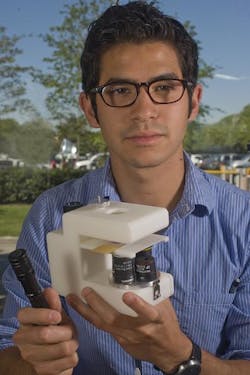Compact microscope matches performance of expensive fluorescence microscope in diagnosing tuberculosis

Houston, TX--A compact microscope invented at Rice University is proving its potential to impact global health with inexpensive medical diagnosis. Rice alumnus Andrew Miller and his colleagues have shown that his portable, battery-operated fluorescence microscope, which costs $240, stacks up well against devices that retail for as much as $40,000 in diagnosing signs of tuberculosis.1
Miller and colleagues at The Methodist Hospital Research Institute (TMHRI) analyzed samples from 19 patients suspected of having tuberculosis. His instrument, called the Global Focus microscope, performed just as well as the lab's reference-standard fluorescence microscope. The team reported similar findings were obtained in 98.4% the samples tested.
Lit by a flashlight
Miller created the 2.5 lb. microscope as his senior-design project last year at Rice. The goal was to make an inexpensive, portable, and highly capable microscope that could be used in clinics in developing countries that have limited access to lab equipment and may lack electricity. The microscope was built with off-the-shelf parts encased in a rugged plastic shell Miller created with a 3-D printer. Light to power the 1,000-times magnification microscope comes from a top-mounted LED flashlight. Miller has since replaced the microscope's plastic casing with aluminum for better stability.
The Global Focus microscope won this year's Hershel M. Rich Invention Award, which is presented annually by Rice Engineering Alumni to a Rice faculty member or student who has developed an original invention. It was the first undergraduate project to win the award. Miller and Rice have contracted with a medical device consultant, 3rd Stone Design, to produce 20 microscopes that will be ready for field testing next month.
Four days of blind testing of 63 smear samples, including control slides, confirmed that the Global Focus microscope was every bit as capable as the lab's more sophisticated instrument in identifying positive smear specimens.
REFERENCE:
1. http://www.plosone.org/article/info%3Adoi%2F10.1371%2Fjournal.pone.0011890

John Wallace | Senior Technical Editor (1998-2022)
John Wallace was with Laser Focus World for nearly 25 years, retiring in late June 2022. He obtained a bachelor's degree in mechanical engineering and physics at Rutgers University and a master's in optical engineering at the University of Rochester. Before becoming an editor, John worked as an engineer at RCA, Exxon, Eastman Kodak, and GCA Corporation.